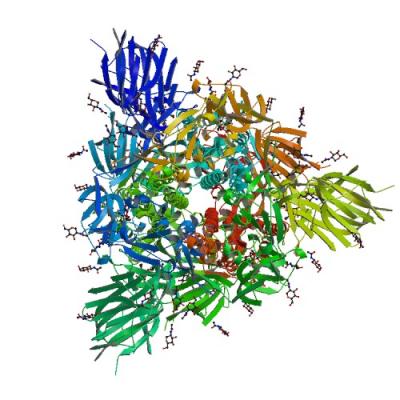
NIAID-funded investigators at the SSGCID determined the structure and function of the SARS-CoV-2 spike glycoprotein. The findings were made available in the Protein Data Bank and published in Cell.
The CRSTAL-ID program, formerly known as the Structural Genomics Centers, supports the characterization of the 3D structure of proteins of infectious disease pathogens. Each Center is a collaborative effort consisting of teams from multiple academic institutions/companies. Protein structures are requested by NIAID or the extramural research community and are made publicly available through online databases such as the Protein Data Bank. The structures help investigators better understand pathogen activity on a molecular level and assist in the identification of targets for drugs, vaccines, and other medical countermeasures.
Pandemic Preparedness Research Activities
Researchers funded through the CRSTAL-ID program have been at the forefront of basic and preclinical research activities for emerging infectious disease pathogens. For example, they have solved the structures of numerous SARS-CoV-2 proteins of high interest, including the spike protein, and have contributed substantially to the number of SARS-CoV-2 structures currently available in the Protein Data Bank. These efforts have provided critical insights into the molecular structure and mechanistic functions of SARS-CoV-2. In addition, CRSTAL-ID researchers have been active in efforts to identify and develop novel therapeutics, vaccines, and diagnostics for COVID-19. They have shown how different therapeutics bind to SARS-CoV-2 and have conducted preclinical screening to identify approved and candidate therapeutics with activity against SARS-CoV-2. They are using computational methods to facilitate the development of diagnostics and have been instrumental in structure-based vaccine design activities and efforts to determine correlates of protection for COVID-19.
Center Locations
Main Areas of Focus
The Centers provide the research community with
- Experimental 3-D protein structures and protein-ligand complexes (X-ray, NMR, CryoEM structures of NIAID category A-C priority agents and organisms causing emerging and re-emerging infectious diseases). 3-D structures and target lists can be found at:
- Sequence-verified clones, and peptides.
- Services that deliver requested 3-D structure determination.
- Molecular screening of proteins in complex with inhibitors, cofactors and substrate analogs
News and Announcements
- Tiny Nanoparticles Could Be A Big Jump for Flu Vaccines
- Scientists Take Aim at the Coronavirus Toolkit – Pacific Northwest National Laboratory
- New Drug Target Found for COVID-19 – Northwestern University Feinberg School of Medicine
- New coronavirus protein, mapped in Chicago, reveals drug target – University of Chicago
- Zeroing in on COVID-19 – Seattle Children’s Hospital Research Foundation
- COVID-19 coronavirus spike holds infectivity details – UW Medicine
Publications
- Structure, Function, and Antigenicity of the SARS-CoV-2 Spike Glycoprotein
- De novo design of picomolar SARS-CoV-2 miniprotein inhibitors
- Cross-neutralization of SARS-CoV-2 by a human monoclonal SARS-CoV antibody
- Broad-spectrum inhibition of coronavirus main and papain-like proteases by HCV drugs
- Distinct B cell subsets give rise to antigen-specific antibody responses against SARS-CoV-2
- High-resolution structures of the SARS-CoV-2 2′-O-methyltransferase reveal strategies for structure-based inhibitor design
For more advances in research see CSGID Publications and SSGCID Publications.
Contact Information
- Dr. Keehwan Kwon, Program Officer

